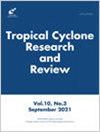Assessing the impact of climate change on land-falling tropical cyclones (LFTCs) over the North Indian Ocean (NIO) and their effects on coastal agriculture in Maharashtra: A case study
IF 4.1
4区 地球科学
Q3 METEOROLOGY & ATMOSPHERIC SCIENCES
引用次数: 0
Abstract
The intensity of tropical cyclonic storms formed over the North Indian Ocean (NIO) has increased over the last two decades. The increasing severity of cyclonic storms has serious socioeconomic and agricultural consequences. Many people are concerned about the impact of global warming caused by climate change on extreme weather events, such as the frequency and intensity of Tropical Cyclones (TCs) that form over global ocean basins. High-intensity cyclones have become more common in the NIO, posing significant risks and vulnerability to coastal communities.
The World Meteorological Organization (WMO) reported that the warmest year was 2015–21, and the warmest decade was 2011–2020, which could be attributed to increased levels of greenhouse gases. However, few studies on the impact of climate change on various characteristics of Land-falling Tropical Cyclones (LFTCs) between 2001 and 2021 have been conducted. As a result, we performed an analysis to evaluate the impact of climate change on various characteristics of LFTCs, such as TC patterns, eye scenes, over land duration, Land-falling intensity (LFI) of LFTCs formed between the years 2000 and 2021. TCs formed over the NIO (2001–2021) crossed the coast with higher LFI and have shown a significant increasing trend in current intensity. Furthermore, more overland duration, eye-pattern TCs, and eye scenes were observed between 2000 and 2021.
This study also assessed the impact of Severe Cyclonic Storm (SCS) Nisarga on coastal agriculture of Maharashtra in terms of vegetation, and shoreline dynamics. The Nisarga’s landfall caused huge socioeconomic as well as agricultural damages including torrential rainfall, storm surges, and saltwater intrusion, causing biodiversity loss and prolonged soil degradation. Normalized differential vegetation index (NDVI) and Enhanced Vegetation Index (EVI) indices revealed a sharp decline in vegetation health during post-cyclone with slow recovery in the subsequent months. The findings of this study could be used to improve the accuracy of operational forecasting of TCs over the North Indian Ocean basins. The results also highlight the need for targeted coastal management, including mangrove restoration and adaptive agricultural strategies, to enhance resilience against future LFTCs.
评估气候变化对北印度洋登陆热带气旋(LFTCs)的影响及其对马哈拉施特拉邦沿海农业的影响:一个案例研究
近20年来,在北印度洋(NIO)上空形成的热带气旋风暴强度有所增加。日益严重的气旋风暴具有严重的社会经济和农业后果。许多人担心气候变化引起的全球变暖对极端天气事件的影响,例如在全球海洋盆地上形成的热带气旋(tc)的频率和强度。高强度气旋在NIO地区变得更加常见,给沿海社区带来了巨大的风险和脆弱性。世界气象组织(WMO)报告称,最温暖的年份是2015-21年,最温暖的十年是2011-2020年,这可能归因于温室气体水平的增加。然而,关于气候变化对2001 - 2021年间登陆热带气旋各特征的影响的研究却很少。因此,我们进行了分析,评估了气候变化对2000 - 2021年间形成的LFTCs的各种特征(如TC模式、眼景、土地持续时间、土地降落强度(LFI))的影响。在NIO上形成的tc(2001-2021)以较高的LFI越过海岸,且电流强度呈显著增加趋势。此外,在2000年至2021年期间,陆地持续时间、眼型tc和眼景的观测值有所增加。本研究还从植被和海岸线动态方面评估了强气旋风暴尼萨尔加对马哈拉施特拉邦沿海农业的影响。“尼萨尔加”的登陆造成了巨大的社会经济和农业损失,包括暴雨、风暴潮和盐水入侵,造成生物多样性丧失和长期土壤退化。归一化植被指数(NDVI)和增强植被指数(EVI)显示气旋后植被健康状况急剧下降,随后数月恢复缓慢。本研究结果可用于提高北印度洋盆地TCs业务预报的准确性。研究结果还强调了有针对性的沿海管理的必要性,包括红树林恢复和适应性农业战略,以增强对未来LFTCs的抵御能力。
本文章由计算机程序翻译,如有差异,请以英文原文为准。
求助全文
约1分钟内获得全文
求助全文
来源期刊

Tropical Cyclone Research and Review
METEOROLOGY & ATMOSPHERIC SCIENCES-
CiteScore
4.60
自引率
3.40%
发文量
184
审稿时长
30 weeks
期刊介绍:
Tropical Cyclone Research and Review is an international journal focusing on tropical cyclone monitoring, forecasting, and research as well as associated hydrological effects and disaster risk reduction. This journal is edited and published by the ESCAP/WMO Typhoon Committee (TC) and the Shanghai Typhoon Institute of the China Meteorology Administration (STI/CMA). Contributions from all tropical cyclone basins are welcome.
Scope of the journal includes:
• Reviews of tropical cyclones exhibiting unusual characteristics or behavior or resulting in disastrous impacts on Typhoon Committee Members and other regional WMO bodies
• Advances in applied and basic tropical cyclone research or technology to improve tropical cyclone forecasts and warnings
• Basic theoretical studies of tropical cyclones
• Event reports, compelling images, and topic review reports of tropical cyclones
• Impacts, risk assessments, and risk management techniques related to tropical cyclones
 求助内容:
求助内容: 应助结果提醒方式:
应助结果提醒方式:


